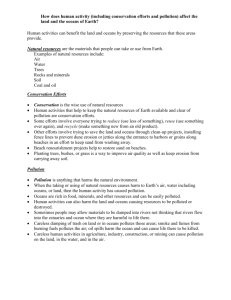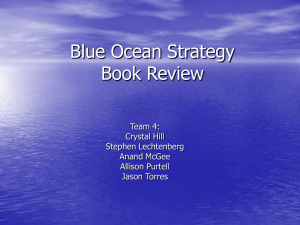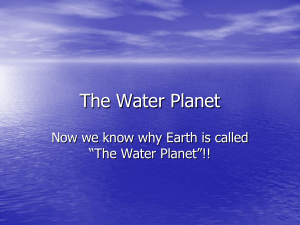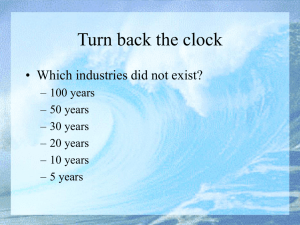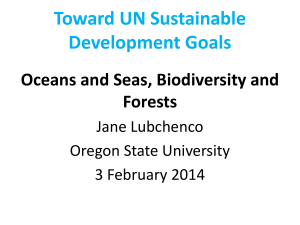5-3.6 - S2TEM Centers SC
advertisement
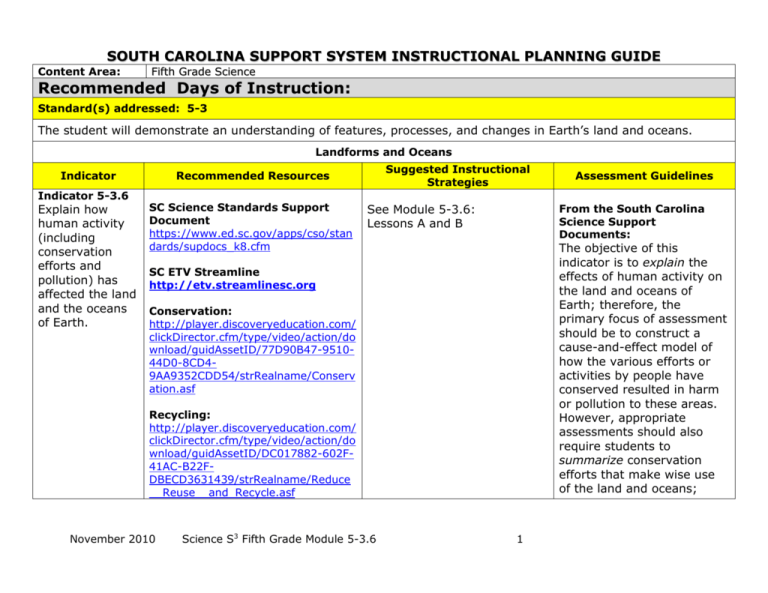
SOUTH CAROLINA SUPPORT SYSTEM INSTRUCTIONAL PLANNING GUIDE Content Area: Fifth Grade Science Recommended Days of Instruction: Standard(s) addressed: 5-3 The student will demonstrate an understanding of features, processes, and changes in Earth’s land and oceans. Landforms and Oceans Indicator Indicator 5-3.6 Explain how human activity (including conservation efforts and pollution) has affected the land and the oceans of Earth. Suggested Instructional Strategies Recommended Resources SC Science Standards Support Document https://www.ed.sc.gov/apps/cso/stan dards/supdocs_k8.cfm From the South Carolina Science Support Documents: See Module 5-3.6: Lessons A and B The objective of this indicator is to explain the effects of human activity on the land and oceans of Earth; therefore, the primary focus of assessment should be to construct a cause-and-effect model of how the various efforts or activities by people have conserved resulted in harm or pollution to these areas. However, appropriate assessments should also require students to summarize conservation efforts that make wise use of the land and oceans; SC ETV Streamline http://etv.streamlinesc.org Conservation: http://player.discoveryeducation.com/ clickDirector.cfm/type/video/action/do wnload/guidAssetID/77D90B47-951044D0-8CD49AA9352CDD54/strRealname/Conserv ation.asf Recycling: http://player.discoveryeducation.com/ clickDirector.cfm/type/video/action/do wnload/guidAssetID/DC017882-602F41AC-B22FDBECD3631439/strRealname/Reduce __Reuse__and_Recycle.asf November 2010 Science S3 Fifth Grade Module 5-3.6 Assessment Guidelines 1 summarize activities that pollute the land or oceans; identify areas of the land or ocean where resources are being conserved; or exemplify ways that the human activities affect land and oceans. Disaster in the Gulf: A Race against Time http://player.discoveryeducation.com/ index.cfm?guidAssetId=581AAF9193FD-48F8-B334C8F9DF105C3D&blnFromSearch=1&pr oductcode=US Take a behind-the-scenes look at the engineering efforts to stop the 2010 Deep Water Horizon oil spill in the Gulf of Mexico, the worst environmental catastrophe in U.S. history. The program follows an elite team of chemists and engineers from the federal government and private companies as they attempt to plug the leak inside the oil rig 5,000 feet below the water's surface. On the Louisiana coast, biologists and environmentalists struggle to keep the oil from damaging the area's fragile ecosystems. NOTE: Please preview this program before showing it to students. Interactive Site/Recycling: http://www.ecokids.ca/pub/kids_hom e.cfm Variety of Cause and Effect Models http://www.educationoasis.com/curric ulum/GO/cause_effect.htm November 2010 Science S3 Fifth Grade Module 5-3.6 2 Interactive site for students to construct Cause and Effect models http://www.readwritethink.org/files/r esources/interactives/essaymap/ Books: Air Pollution by Darlene R. Stille Water Pollution by Darlene R. Stille Conservation by Richard Gates This is Our Earth by Laura Lee Benson Just a Dream by Chris Van Allsburg November 2010 Science S3 Fifth Grade Module 5-3.6 3 Fifth Grade Science Module 5-3.6 Landforms and Oceans Lesson A Standard (5-3): The student will demonstrate an understanding of features, processes, and changes in Earth’s land and oceans. Indicator (5-3.6): Explain how human activity (including conservation efforts and pollution) has affected the land and the oceans of Earth. November 2010 Science S3 Fifth Grade Module 5-3.6 4 From the South Carolina Science Support Documents: Indicator 5-3.6: Explain how human activity (including conservation efforts and pollution) has affected the land and the oceans of Earth. Taxonomy level: 2.7-B Understand Conceptual Knowledge Previous/Future knowledge: In 4th grade (4-2.6), students explained how organisms cause changes in their environment. In 7th grade (7-4.6), students will explain the implications of the depletion of resources and the importance of conservation of resources. It is essential for students to that human activities can benefit the land and oceans by preserving the resources that these areas provide. Natural resources are the materials that people can take or use from Earth. Resources may include air, water, trees, rocks and minerals, soil, or coal and oil. Conservation Efforts The wise use of natural resources is called conservation. Human activities that help to keep the natural resources of Earth available and clear of pollution are conservation efforts. Some efforts involve everyone trying to reduce (use less of something), reuse (use something over again), and recycle (make something new from an old product). Other efforts involve trying to save the land and oceans through clean-up projects, installing fence lines to prevent dune erosion or jetties along the entrance to harbors or groins along beaches in an effort to keep sand from washing away. Beach re-nourishment projects help to restore sand on beaches. Planting trees, bushes, or grass is a way to improve air quality as well as keep erosion from carrying away soil. Pollution Pollution is anything that harms the natural environment. When the taking or using of natural resources causes harm to Earth’s air, water including oceans, or land, then the human activity has caused pollution. Oceans are rich in food, minerals, and other resources and can be easily polluted. Human activities can also harm the land and oceans causing resources to be polluted or destroyed. Sometimes people may allow materials to be dumped into rivers not thinking that rivers flow into the estuaries and ocean where they are harmful to life there. Careless dumping of trash on land or in oceans pollutes those areas; smoke and fumes from burning fuels pollutes the air; oil spills harm the ocean and can cause life there to be killed. November 2010 Science S3 Fifth Grade Module 5-3.6 5 Careless human activities in agriculture, industry, construction, or mining can cause pollution on the land, in the water, and in the air. Assessment Guidelines: The objective of this indicator is to explain the effects of human activity on the land and oceans of Earth; therefore, the primary focus of assessment should be to construct a cause-and-effect model of how the various efforts or activities by people have conserved resulted in harm or pollution to these areas. However, appropriate assessments should also require students to summarize conservation efforts that make wise use of the land and oceans; summarize activities that pollute the land or oceans; identify areas of the land or ocean where resources are being conserved; or exemplify ways that the human activities affect land and oceans. November 2010 Science S3 Fifth Grade Module 5-3.6 6 Teaching Indicator 5-3.6: Lesson A - Landforms and Oceans—“Pollution Solution” Instructional Considerations: This lesson is an example of how a teacher might address the intent of this indicator. FOSS Landforms and STC Land and Water kits provide an opportunity for conceptual development of the concepts within the standard. Misconceptions: Marine debris originates from both land-based and ocean-based sources. The 60-80 percentages often referred to by the media and others actually refers to a broad spectrum of land-based sources, not just one type of pollution. The primary pollution sources affecting the ocean are actually non-point sources of pollution such as agricultural runoff, sewage outfalls, coastal development and solid waste disposal practices and others. Marine debris is included among that long list, but is not responsible for 60-80 percent of the pollution of the oceans. Safety: Safety must be emphasized at the beginning of the school year and reinforced with every lab activity. Students should understand that safety is everyone’s responsibility. Lesson time: 1 day (1 day equals 45 minutes) Materials Needed: Book Just a Dream by Chris Van Allsburg Computer paper and markers Focus Question: How have human activities affected the land and oceans? Engage: 1. Read aloud the book Just a Dream by Chris Van Allsburg. Explore: 1. After reading the book discuss with students the different types of pollution present in the book—chart their responses. 2. Ask students how pollutants such as the ones in this book might affect our land and oceans. Explain: 1. Have students to construct a cause and effect model (see below) of how a particular activity by people has resulted in harm or pollution (ex: throwing trash in the ocean hurts the animals). Encourage students to think of activities that were not discussed in the book. Give students art supplies and allow them to choose the method for their presentation. ***If laptops are available allow students to present their learning through a PPT. November 2010 Science S3 Fifth Grade Module 5-3.6 7 Extend: 1. Allow students to think of ways that they could implement some of their ideas within their own community. Have your students begin a community service project that would bring this standard to life. Cause and Effect Models Variety of Cause and Effect Models http://www.educationoasis.com/curriculum/GO/cause_effect.htm Interactive site for students to construct Cause and Effect models http://www.readwritethink.org/files/resources/interactives/essaymap/ November 2010 Science S3 Fifth Grade Module 5-3.6 8 Teaching Indicator 5-3.6: Lesson B - Landforms and Oceans—“Clean It Up!” Instructional Considerations: This lesson is an example of how a teacher might address the intent of this indicator. FOSS Landforms and STC Land and Water kits provide an opportunity for conceptual development of the concepts within the standard. Misconceptions: By some estimates, over 600 Billion metric tons of plastic debris currently floats in the ocean. The plastic is fragmented into small pieces, scattered throughout the water column and present, in different densities, throughout all the world’s oceans. There are no visible islands of trash anywhere, but rather a ocean soup laced with plastic. This makes cleaning the oceans a very difficult proposition, technically or economically. Any cleanup has the potential to not only remove the plastics but also the plankton, which is the base of the food chain, and is responsible for capturing half of the CO2 of our atmosphere and generating half of the oxygen we need to breathe. We applaud the efforts of any group inspired by a vision of clean oceans and healthy sea life, and working to put an end to plastic pollution. But we also caution that these efforts would only succeed if we work together to stop the 11 Billion metric tons of plastic that is dumped into the ocean each year. Safety: Safety must be emphasized at the beginning of the school year and reinforced with every lab activity. Students should understand that safety is everyone’s responsibility. Lesson time: 1 day (1 day equals 45 minutes) Materials Needed: Per Group: Cork Large clear plastic container Dropper Oil Water Paper towels Sponge Cotton balls Spoon Focus Questions: How can you clean up an oil spill in water? What are some conservation efforts that can be implemented to make wise use of our land and oceans? November 2010 Science S3 Fifth Grade Module 5-3.6 9 Engage: 1. Ask students if they have any prior knowledge of oil spills. Discuss their thoughts and show some images of oil spills (ex: http://response.restoration.noaa.gov/gallery_gallery.php?RECORD_KEY(galle ry_index)=joinphotogal_id,gallery_id,photo_id&joinphotogal_id(gallery_index )=171&gallery_id(gallery_index)=12&photo_id(gallery_index)=106 ). Discuss with students the affects they think the oil spill had on the ocean habitat. Explore: 1. Divide students into groups of 3 or 4. Have one member of each group collect materials. 2. Have students put the cork in the plastic container and observe. 3. Add 6 drops of oil to the water. Now, observe the cork for 2 minutes and record observations. 4. Ask students: How did the cork change after the oil was added? How can you clean the oil spill? 5. Using ideas generated by the students, allow students to “clean” the oil spill. Give students 15 minutes to get ALL of the oil out of the water. Have materials such as paper towels, sponges, cotton balls, and spoons available (or whatever other ideas they may come up with). Explain: 1. After students have attempted to clean up all of the oil, discuss with students the real world applications of this experiment. What if the cork was an animal? What if their pan of water was an ocean? What could be done to clean pan oil spill in an ocean? What are some conservation efforts that can be taken to prevent things like this from happening? Extend: 1. Show students some footage of the recent oil spills and what was/is being done to clean up the oil and the effect it had on ocean life. (see resources) November 2010 Science S3 Fifth Grade Module 5-3.6 10

